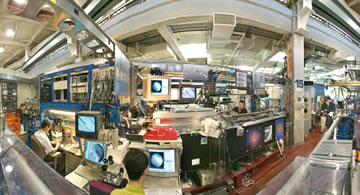
X-Ray and Ultrafast Science, page two
The secrets of chemical reactions reveal themselves in the blink of an eye. To glimpse these processes, Berkeley Lab physicists Alexander Zholents and William Fawley have an idea for creating intense bursts of x-rays in pulse lengths of about 100 attoseconds. How fast is that? In Niels Bohr’s classic 1913 model of a hydrogen atom, it takes about 100 attoseconds for the electron to orbit the proton.
Using their technique, scientists may be able to directly observe phenomena such as an atom becoming ionized, or the bonding of two or more atoms into molecules, by using a flash of light to stimulate an electron, and attosecond x-ray flashes to follow its activities.
“What made our idea possible is the amazing work that has been done with lasers over the past five years,” says Zholents. “Lasers can now provide the intense, few-cycle pulses that we can use to effectively slice attosecond soft x-rays from an ultrarelativistic electron beam.”

ALS Beamline 6.1.2 is a bend magnet beamline used for x-ray microscopy and tomography and 3-D imaging.
Zholents and Fawley’s proposal could be realized at a soon-to-be-completed center for ultrafast science. Berkeley Lab scientists are collaborating with the Stanford Linear Accelerator Center on the development of the Linac Coherent Light Source (LCLS), which will be the world’s first x-ray free electron laser when it becomes operational in 2009. Pulses of laser light from the LCLS will be many orders of magnitude brighter and several orders of magnitude shorter than what can be produced by any other x-ray source. These characteristics will enable frontier science, such as probing new states of matter, following chemical reactions and biological processes in real time, imaging chemical and structural properties of materials on the nanoscale, and imaging noncrystalline biological materials at atomic resolution.
The venerable ALS is also well poised to lead x-ray-driven science for years to come. In the fall of 2001, the ALS underwent a retrofit, replacing three of its conventional storage-ring bend magnets with superconducting magnets or “superbends.” This retrofit, the first ever to take place at an operating synchrotron radiation source, elevated the ALS from being the nation’s premier source of low-energy or “soft” x-rays to also being an important source of high-energy or “hard” x-rays. Plans call for the ALS to be upgraded so that it operates in a “top-off” injection mode, meaning electrons are injected into the storage ring every half minute or so, which keeps the storage-ring current nearly constant. At present, when the ALS is in operation, the storage ring is filled once every eight hours. By operating in a top-off mode, the ALS is expected to undergo a twofold increase in beam brightness. Further increases in beam brightness at a modest cost will be achieved in the future as today’s ALS insertion devices are replaced with superconducting devices.